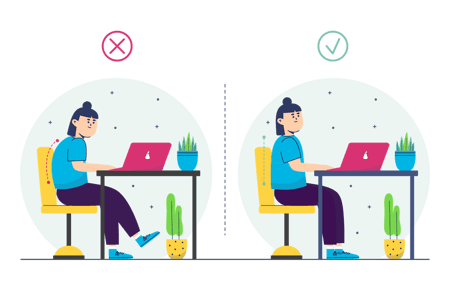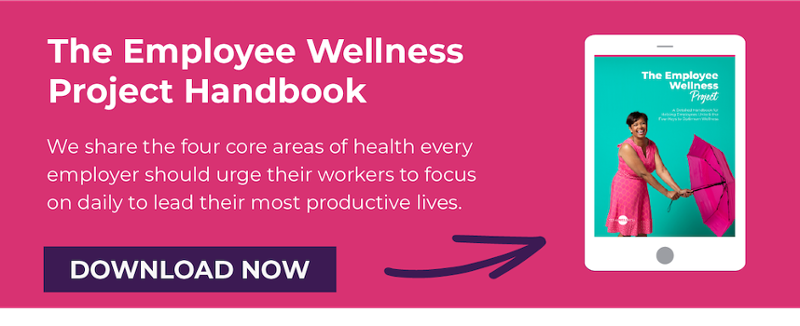 For those working from home, it may be a pain in the neck for more reasons than one — including literal pains in the neck and back.
For those working from home, it may be a pain in the neck for more reasons than one — including literal pains in the neck and back.
Thanks to improper work stations and sedentary lifestyles, neck and back pain is becoming more of a problem for at-home workers. Unfortunately, many remote workers are finding neck, back, leg, and shoulder pain are now becoming the norm, according to the UT Southwestern Medicine Center.
It’s an expensive problem for employees and employers, too.
The American Chiropractic Association reports, “Back pain accounts for more than 264 million lost work days in one year — that’s two work days for every full-time worker in the country.”
Ouch.
With remote work becoming the norm, now is the time to help your team work more comfortably. Here’s a look at how to relieve neck and back pain and how to prevent it in the first place.
Common Causes of Neck and Back Pain in the Workplace
As you may guess, slouching and poor posture is one cause of neck and back pain. But not all back pain comes from lazy sitting methods. A variety of issues may be causing your body to feel consistent pain.
Lower back pain may be caused by:
- Posture
- Sciatica
- Muscle strain
- Herniated disc
- Lack of muscle tone
Experiencing tightness and pain in your upper back and shoulders? Upper back pain is usually due to neck strain from leaning toward digital devices or sitting for too long, which can cause misalignment.
Thankfully, there are simple ways to adjust your habits to find relief.
How to Relieve Neck and Back Pain Caused by Sitting
With a few tweaks to your lifestyle, you can be sitting with better posture and less pain.
It may take some time, but with practice and mindfulness, you can aim for work days with less pain and a more comfortable time sitting.
Here are a few ideas to try:
Stretch
Stretching may be one of the last activities you want to do when you’re in the middle of a project, but stretching is a must. Doing so can loosen up muscles — like your neck — to keep them from feeling too tight. Shoulder rolls, tilting your head side to side, toe touches, and arm circles are all great ways to loosen up your body and keep pain away.
Related: Stretching Benefits: Why Stretching Should Be A Part of Your Life
Exercise
No surprise here, but exercise is essential to keeping your body strong and preventing back and neck pain to begin with. If your back, shoulders, and core are strong, you’re less likely to slouch and feel achy from muscle pain. Incorporate exercises like push-ups, planks, and bridges to your routine to strengthen your lower back muscles.
Related: Workout at Home With No Equipment With These 10 Exercises
Use the Correct Posture
Working at your dining room table — or worse — on your couch? Your posture is likely less than perfect and causing all sorts of misalignment in your spine. Even if you have a desk setup, you still might be putting unwanted pressure on certain ligaments and muscles. A neutral position is best with relaxed shoulders and back fully supported with a lumbar support. Learn more about OSHA’s compliance for computer ergonomics here.
Related: No More Slouching! Here are 7 Tips for Better Posture While You Work
Pay Attention to Mental Health
As it turns out, your mental health has a major impact on more than just your emotions and mental state. If you’re stressed out, your body has a physiological response that you often might miss if you don’t pay close attention. Research shared by the Spine Institute Northwest showed that when depression is left untreated, it can lower pain thresholds and worsen physical symptoms, including back pain. Find ways to keep your mental health in check for overall good physical health. Meditation, journaling, exercise, and talk therapy can all help!
Related: 6 Ways to Encourage Employees to Focus on Their Mental Health
Explore Alternative Treatments
There are always lots of options when it comes to treating your health, especially when it comes to pain. Here are a few natural, alternative methods to consider as well:
- Foam roller - Have a tight spot in your hip or buttocks? Using a foam roller can help you loosen up trigger points in hard-to-reach areas via a self-massage. Doing so on a regular basis can prevent muscles from getting too tight. It’s also an easy exercise to do in tight spaces.
- Yoga - Adding yoga into your everyday routine is a great way to maintain flexibility and strength. It also keeps muscles limber, making them less likely to tighten up. Yoga moves may also improve core strength, which includes the muscles that are key to helping you sit properly.
- Get a massage - This ancient practice is known to loosen and relax tight muscles. It also reduces stress and improves circulation.
- Try acupuncture - Another ancient alternative medicine approach, acupuncture uses needles to trigger specific points in the body tied to certain ailments. It stimulates sensitive nerves tied to various organs and other body functions as a way to improve specific health conditions like neck or back pain.
Facts About Neck and Back Pain
Unfortunately, back and neck pain aren’t strangers to most people. UT Health Austin estimates that 80% of people will experience back or neck pain at some point during their lives. Worse yet, globally, back pain is the single leading cause of disability, according to the American Chiropractic Association.
Some facts about neck and back pain:
- X-rays don’t share much - Arthritis is one of the conditions that can be shown on an x-ray. While that can certainly cause pain issues, you’ll likely find back pain is caused by a strain or sprain of the muscles and ligaments.
- Back pain recovery is possible - Most people find they’ll recover with low back pain issues with some physical therapy and regular, appropriate exercise. Others may have recurring pain that can cause disability.
- Back pain causes absences - Unfortunately, back pain is a common reason for missed work. Half of working Americans claim back pain symptoms annually.
- Symptoms vary for neck pain - Neck pain may cause headaches, an inability to move the head, and muscle spasms.
- Stay centered - By keeping the head centered over the spine, individuals can prevent neck strain and back pain by maintaining a good posture.
When in pain, consider ice, heat, stretching, and exercise as a way to alleviate the symptoms. Small adjustments to your working conditions can also help ease neck and back pain. Speak to your doctor when in doubt on how to move forward with self-treatment or pain remedies.
Help Your Team Stay Pain-Free
Neck and back pain can cause a lot of issues for your employees. Do what you can to help them alleviate it and encourage them to stay healthy — especially when it comes to strengthening exercises. After all, if the back and neck are strong, the rest of their body is likely strong, too.
Lastly, here are a few more tips to help your team avoid pain:
- Peek at posture - If possible, have your employees put a mirror next to their workstation to help them keep an eye on how they're sitting throughout the day. Alternatively, they could have a family member or roommate take a picture of them engaged in work to show how they could better their posture.
- Send reminders - Remote workers who are on computers all day long tend to forget to take breaks. Send them friendly little auto reminders on the hour to get up and stretch.
- Share helpful content - Any time you come across health content related to the back, neck, or spine, share it with your team. You might consider sending this stretching benefits article to them, too!
Whether it's constant pain, ongoing doctors’ appointments, or even surgery, helping your employees get ahead of such pain can make all the difference. Ask your employees to consider how they can adjust repetitive movements and avoid sitting all day long for a healthier neck and spine.
Want to keep your team focused on wellness and fitness? Check out our 6 Easy Fitness and Wellness Challenges for Any Workplace!



